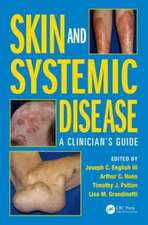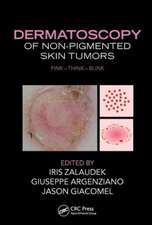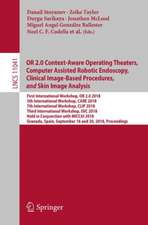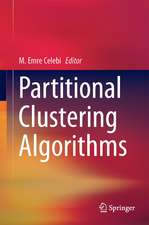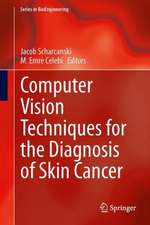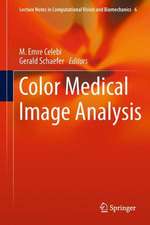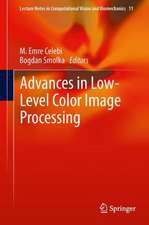Dermoscopy Image Analysis: Digital Imaging and Computer Vision
Editat de M. Emre Celebi, Teresa Mendonca, Jorge S. Marquesen Limba Engleză Hardback – 16 oct 2015
Dermoscopy Image Analysis summarizes the state of the art of the computerized analysis of dermoscopy images. The book begins by discussing the influence of color normalization on classification accuracy and then:
- Investigates gray-world, max-RGB, and shades-of-gray color constancy algorithms, showing significant gains in sensitivity and specificity on a heterogeneous set of images
- Proposes a new color space that highlights the distribution of underlying melanin and hemoglobin color pigments, leading to more accurate classification and border detection results
- Determines that the latest border detection algorithms can achieve a level of agreement that is only slightly lower than the level of agreement among experienced dermatologists
- Provides a comprehensive review of various methods for border detection, pigment network extraction, global pattern extraction, streak detection, and perceptually significant color detection
- Details a computer-aided diagnosis (CAD) system for melanomas that features an inexpensive acquisition tool, clinically meaningful features, and interpretable classification feedback
- Presents a highly scalable CAD system implemented in the MapReduce framework, a novel CAD system for melanomas, and an overview of dermatological image databases
- Describes projects that made use of a publicly available database of dermoscopy images, which contains 200 high-quality images along with their medical annotations
Preț: 1022.07 lei
Preț vechi: 1370.84 lei
-25% Nou
Puncte Express: 1533
Preț estimativ în valută:
195.57€ • 204.74$ • 161.82£
195.57€ • 204.74$ • 161.82£
Carte tipărită la comandă
Livrare economică 05-19 aprilie
Preluare comenzi: 021 569.72.76
Specificații
ISBN-13: 9781482253269
ISBN-10: 1482253267
Pagini: 506
Ilustrații: 655 black & white illustrations, 185 colour illustrations, 64 black & white tables, 72 colour tables
Dimensiuni: 156 x 234 mm
Greutate: 0.86 kg
Ediția:1
Editura: CRC Press
Colecția CRC Press
Seria Digital Imaging and Computer Vision
ISBN-10: 1482253267
Pagini: 506
Ilustrații: 655 black & white illustrations, 185 colour illustrations, 64 black & white tables, 72 colour tables
Dimensiuni: 156 x 234 mm
Greutate: 0.86 kg
Ediția:1
Editura: CRC Press
Colecția CRC Press
Seria Digital Imaging and Computer Vision
Cuprins
Toward a Robust Analysis of Dermoscopy Images Acquired under Different Conditions. A Bioinspired Color Representation for Dermoscopy Image Analysis. Where’s the Lesion? Variability in Human and Automated Segmentation of Dermoscopy Images of Melanocytic Skin Lesions. A State-of-the-Art Survey on Lesion Border Detection in Dermoscopy Images. Comparison of Image Processing Techniques for Reticular Pattern Recognition in Melanoma Detection. Global Pattern Classification in Dermoscopic Images. Streak Detection in Dermoscopic Color Images Using Localized Radial Flux of Principal Intensity Curvature. Dermoscopy Image Assessment Based on Perceptible Color Regions. Improved Skin Lesion Diagnostics for General Practice by Computer-Aided Diagnostics. Accurate and Scalable System for Automatic Detection of Malignant Melanoma. Early Detection of Melanoma in Dermoscopy of Skin Lesion Images by Computer Vision-Based System. From Dermoscopy to Mobile Teledermatology. PH2: A Public Database for the Analysis of Dermoscopic Images.
Notă biografică
M. Emre Celebi earned a B.Sc in computer engineering at the Middle East Technical University, Ankara, Turkey, in 2002. He earned M.Sc and Ph.D degrees in computer science and engineering at the University of Texas at Arlington, USA, in 2003 and 2006, respectively. A senior member of the IEEE and SPIE, he is currently an associate professor and the founding director of the Image Processing and Analysis Laboratory, Department of Computer Science, Louisiana State University, Shreveport, USA. Widely published, Dr. Celebi has worked on several projects funded by the U.S. National Science Foundation and National Institutes of Health.
Teresa F. Mendonça earned mathematics and Ph.D degrees at the University of Porto, Portugal, in 1980 and 1993, respectively. Currently, she is an assistant professor with the Mathematics Department, Faculty of Sciences, University of Porto, and a researcher at the Institute for Systems and Robotics–Porto. Her research interests are in the areas of identification, modeling, and control applied to the biomedical field. In recent years, she has been involved in projects for modeling and control in anesthesia and in medical image analysis.
Jorge S. Marques earned EE, Ph.D, and aggregation degrees at the Technical University of Lisbon, Portugal, in 1981, 1990, and 2002, respectively. Currently, he is an associate professor with the Electrical and Computer Engineering Department, Instituto Superior Técnico, Lisbon, Portugal, and a researcher at the Institute for Systems and Robotics, Portugal. He was the co-chairman of the IAPR Conference IbPRIA 2005, president of the Portuguese Association for Pattern Recognition (2001–2003), and associate editor of the Statistics and Computing Journal, Springer. His research interests are in the areas of statistical image processing, medical image analysis, and pattern recognition.
Teresa F. Mendonça earned mathematics and Ph.D degrees at the University of Porto, Portugal, in 1980 and 1993, respectively. Currently, she is an assistant professor with the Mathematics Department, Faculty of Sciences, University of Porto, and a researcher at the Institute for Systems and Robotics–Porto. Her research interests are in the areas of identification, modeling, and control applied to the biomedical field. In recent years, she has been involved in projects for modeling and control in anesthesia and in medical image analysis.
Jorge S. Marques earned EE, Ph.D, and aggregation degrees at the Technical University of Lisbon, Portugal, in 1981, 1990, and 2002, respectively. Currently, he is an associate professor with the Electrical and Computer Engineering Department, Instituto Superior Técnico, Lisbon, Portugal, and a researcher at the Institute for Systems and Robotics, Portugal. He was the co-chairman of the IAPR Conference IbPRIA 2005, president of the Portuguese Association for Pattern Recognition (2001–2003), and associate editor of the Statistics and Computing Journal, Springer. His research interests are in the areas of statistical image processing, medical image analysis, and pattern recognition.
Recenzii
"… demonstrates the significant advancements in dermoscopy image analysis techniques, involving image-preprocessing, lesion segmentation (or border detection), feature extraction, pattern analysis, lesion classification, and database construction. The approaches described are state of the art and the details are sine qua non. … a good addition on the dermatologist and researcher’s bookshelf, and pilots further research in this field."
—Fengying Xie, Image Processing Center, Beihang University, Beijing, China
"… a comprehensive description of computerized image analysis that is definitely useful for researchers in this field as a starting point for future developments."
—Giuseppe Argenziano, Dermatology Unit, Second University of Naples, Italy
"… collect[s] high-quality research articles on dermoscopy image analysis. … presents the latest state-of-the-art techniques for classifying benign and malignant skin lesions. A very interesting point that emerged from the literature review, as one author points out, is that all these computer-aided diagnosis (CAD) systems offer invaluable help to the general practitioner (GP) in an initial diagnosis of the lesions. The high level of performance of these systems can thus provide an accurate evaluation of skin lesions without having to refer to a dermatologist at this initial stage."
—Lucia Ballerini, University of Edinburgh, Scotland
"… deals with a very important and hot topic that attracts the interest of many researchers and doctors in the scientific community nowadays. … well written and clear. It provides a good overview of the dermoscopy image analysis field, and it is useful for engineers and computer scientists interested in developing similar applications, since it includes in-depth technical descriptions."
—Ilias Maglogiannis, University of Piraeus, Greece
"… I definitely would like to have this book [on] my shelf. … a valuable resource for researchers and graduate students of computer vision and medical image analysis interested in skin cancer detection methods for dermoscopic images. It covers fundamentals of the area by providing thorough treatments of the theory and the concepts while making the material accessible to the reader with examples that nicely illustrate the concepts."
—Jacob Scharcanski, Universidade Federal do Rio Grande do Sul, Brazil
"… provides a comprehensive, well-rounded coverage on the factors, challenges, and state-of-the-art solutions to the very difficult problem of dermascopy image analysis. … a good reference to have in the libraries of researchers in this field."
—Alexander Wong, University of Waterloo, Ontario, Canada
—Fengying Xie, Image Processing Center, Beihang University, Beijing, China
"… a comprehensive description of computerized image analysis that is definitely useful for researchers in this field as a starting point for future developments."
—Giuseppe Argenziano, Dermatology Unit, Second University of Naples, Italy
"… collect[s] high-quality research articles on dermoscopy image analysis. … presents the latest state-of-the-art techniques for classifying benign and malignant skin lesions. A very interesting point that emerged from the literature review, as one author points out, is that all these computer-aided diagnosis (CAD) systems offer invaluable help to the general practitioner (GP) in an initial diagnosis of the lesions. The high level of performance of these systems can thus provide an accurate evaluation of skin lesions without having to refer to a dermatologist at this initial stage."
—Lucia Ballerini, University of Edinburgh, Scotland
"… deals with a very important and hot topic that attracts the interest of many researchers and doctors in the scientific community nowadays. … well written and clear. It provides a good overview of the dermoscopy image analysis field, and it is useful for engineers and computer scientists interested in developing similar applications, since it includes in-depth technical descriptions."
—Ilias Maglogiannis, University of Piraeus, Greece
"… I definitely would like to have this book [on] my shelf. … a valuable resource for researchers and graduate students of computer vision and medical image analysis interested in skin cancer detection methods for dermoscopic images. It covers fundamentals of the area by providing thorough treatments of the theory and the concepts while making the material accessible to the reader with examples that nicely illustrate the concepts."
—Jacob Scharcanski, Universidade Federal do Rio Grande do Sul, Brazil
"… provides a comprehensive, well-rounded coverage on the factors, challenges, and state-of-the-art solutions to the very difficult problem of dermascopy image analysis. … a good reference to have in the libraries of researchers in this field."
—Alexander Wong, University of Waterloo, Ontario, Canada
Descriere
Dermoscopy is a noninvasive skin imaging technique that uses optical magnification and either liquid immersion or cross-polarized lighting to make subsurface structures more visible when compared to conventional clinical images. It allows for the identification of dozens of morphological features that are particularly important in identifying malignant melanoma. This book summarizes the state of the art of the computerized analysis of dermoscopy images, covering dermoscopy image analysis from preprocessing to classification. The text also explores future directions for this exciting subfield of medical image analysis.













